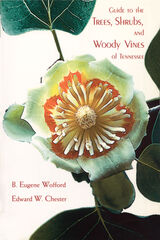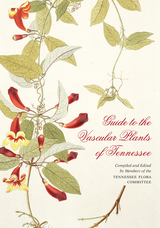2 books by Wofford, S. Eugene

Guide To The Trees Shrubs & Woody Vines
S. Eugene Wofford
University of Tennessee Press, 2002
Tennessee is home to more than four hundred species of woody plants, but until now there has been no comprehensive guide to them. This work fills that gap, as B. Eugene Wofford and Edward W. Chester provide identification keys to all native and naturalized species of trees, shrubs, and woody vines found in the state.
The book is organized by plant types, which are divided into gymnosperms and angiosperms. For each species treated, the authors include both scientific and common names, a brief description, information on flowering and fruiting seasons, and distribution patterns. Photographs illustrate more than ninety five percent of species, and the text is fully indexed by families and genera, scientific names, and common names. A glossary is keyed to photographs in the text to illustrate definitions.
In their introduction, Wofford and Chester provide an overview of the Tennessee flora and their characteristics, outline Tennessee’s physiographic regions, and survey the history of botanical research in the state. The authors also address the historical and environmental influences on plant distribution and describe comparative diversity of taxa within the regions.
Guide to Trees, Shrubs, and Woody Vines of Tennessee will be a valuable resource and identification guide for professional and lay readers alike, including students, botanists, foresters, gardeners, environmentalists, and conservationists interested in the flora of Tennessee.
The book is organized by plant types, which are divided into gymnosperms and angiosperms. For each species treated, the authors include both scientific and common names, a brief description, information on flowering and fruiting seasons, and distribution patterns. Photographs illustrate more than ninety five percent of species, and the text is fully indexed by families and genera, scientific names, and common names. A glossary is keyed to photographs in the text to illustrate definitions.
In their introduction, Wofford and Chester provide an overview of the Tennessee flora and their characteristics, outline Tennessee’s physiographic regions, and survey the history of botanical research in the state. The authors also address the historical and environmental influences on plant distribution and describe comparative diversity of taxa within the regions.
Guide to Trees, Shrubs, and Woody Vines of Tennessee will be a valuable resource and identification guide for professional and lay readers alike, including students, botanists, foresters, gardeners, environmentalists, and conservationists interested in the flora of Tennessee.
[more]

Guide to the Vascular Plants of Tennessee
Edward W. Chester
University of Tennessee Press, 2015
The product of twenty-five years of planning, research, and writing, Guide to the Vascular Plants of Tennessee is the most comprehensive, detailed, and up-to-date resource of its kind for the flora of the Volunteer State, home to nearly 2,900 documented taxa. Not since Augustin Gattinger’s 1901 Flora of Tennessee and a Philosophy of Botany has a work of this scope been attempted.
The team of editors, authors, and contributors not only provide keys for identifying the major groups, families, genera, species, and lesser taxa known to be native or naturalized within the state—with supporting information about distribution, frequency of occurrence, conservation status, and more—but they also offer a plethora of descriptive information about the state’s physical environment and vegetation, along with a summary of its rich botanical history, dating back to the earliest Native American inhabitants.
Other features of the book include a comprehensive glossary of botanical terms and an array of line drawings that illustrate the identifying characteristics of vascular plants, from leaf shape and surface features to floral morphology and fruit types. Finally, the book’s extensive keys are indexed by families, scientific names, and common names. The result is a user-friendly work that researchers, students, environmentalists, foresters, conservationists, and indeed anyone interested in Tennessee and its botanical legacy and resources will value for years to come.
The team of editors, authors, and contributors not only provide keys for identifying the major groups, families, genera, species, and lesser taxa known to be native or naturalized within the state—with supporting information about distribution, frequency of occurrence, conservation status, and more—but they also offer a plethora of descriptive information about the state’s physical environment and vegetation, along with a summary of its rich botanical history, dating back to the earliest Native American inhabitants.
Other features of the book include a comprehensive glossary of botanical terms and an array of line drawings that illustrate the identifying characteristics of vascular plants, from leaf shape and surface features to floral morphology and fruit types. Finally, the book’s extensive keys are indexed by families, scientific names, and common names. The result is a user-friendly work that researchers, students, environmentalists, foresters, conservationists, and indeed anyone interested in Tennessee and its botanical legacy and resources will value for years to come.
[more]
READERS
Browse our collection.
PUBLISHERS
See BiblioVault's publisher services.
STUDENT SERVICES
Files for college accessibility offices.
UChicago Accessibility Resources
home | accessibility | search | about | contact us
BiblioVault ® 2001 - 2024
The University of Chicago Press









